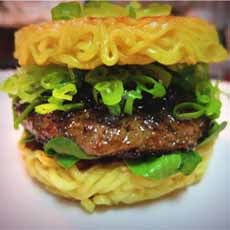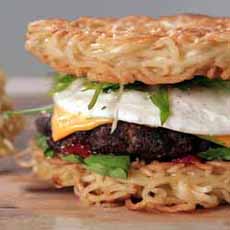FOOD FUN: Make A Ramen Burger For National Ramen Day
|
April 4th is National Ramen Day. It’s also National Burrito Day, National Carrot Day and National Cordon Bleu Day. In case you’ve never had a ramen burger, it’s a hamburger where fried ramen, formed into a bun shape, replaces the bread bun. The American version of the ramen burger (photo #1) was created in 2013 by Keizo Shimamoto, a ramen blogger turned ramen chef (his ramen shop closed last week). He had inspiration from ramen burgers he saw while in Japan. Restaurants there used ramen noodles to form a top and bottom, although the top and bottom “buns” were not as solidified as Keizo’s ramen buns. Instead of a beef patty, the Japanese filled the ramen buns with chashu pork. Chashu pork is pork belly braised in soy sauce, sake, and mirin (rice wine*). The inspiration is that bowls of ramen soup are often topped with slices of the braised pork belly. Creating a Japanese-American fusion, Keizo sandwiched a beef burger slathered in a “secret” shoyu sauce (soy sauce seasoned with brown sugar, garlic, ginger and shallot) instead of ketchup. Arugula and a scallion garnish taking over for lettuce and onion. Here’s the whole story. The ramen burger started a craze among food bloggers everywhere, who created their own versions. After checking out different recipes online, we chose this one from Pigamitha Dimar (photo #2). Different bloggers add different touches; for example, cheese and/or a fried egg (photo #2 (bottom burger) and photo #3). If you just want to know how to make the ramen “buns,” here’s the scoop from Nona Lim: Consider Kewpie brand mayonnaise†, Japan’s favorite mayo. Any burger works: beef, grain, lamb, turkey, veggie, etc.You can even make it a double, as in photo #2. |
|
|
|
Whatever burger you choose, you can add Japanese condiments and spices to the chopped meat for extra flavor. Ready to create your own ramen burger? It’s a fine way to celebrate National Ramen Day. > THE GROWTH OF RAMEN IN JAPAN, PRE- AND POST- WORLD WAR II *Mirin and saké are both called “rice wine.” Both are fermented from rice; mirin has a lower alcohol content and higher sugar content (as an analogy, think of sweet and dry vermouths. If you have saké but no mirin, make a substitute by adding a half teaspoon of sugar to the saké, and warm it slowly to dissolve the sugar. †It’s made with more egg yolks, rice vinegar instead of distilled white vinegar, and MSG.
|
||





